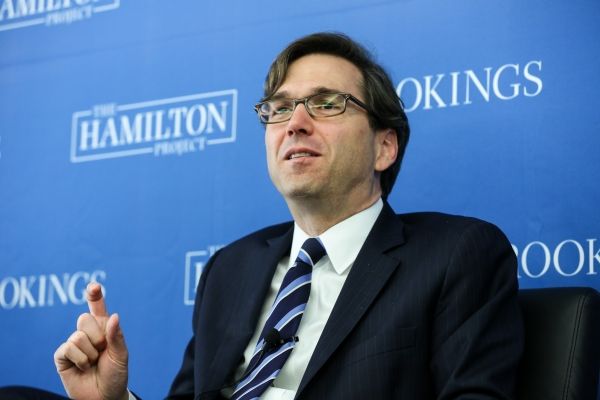Last week, the President’s Council of Economic Advisers (CEA) released a new report about the change in labor force participation and how it relates to the underlying demographic, structural, and cyclical trends affecting the labor market. On July 17th, CEA Chairman Jason Furman joined The Hamilton Project for a forum in Washington, DC to discuss the report and the implications these labor force changes have for outstanding challenges like lowering long-term unemployment, raising wages, and expanding the economy's potential. Following Furman’s featured remarks, he was joined by former U.S. Treasury Secretary Robert E. Rubin and Princeton University economist Alan Blinder for a roundtable discussion.
 Jason Furman, Chairman of the President's Council of Economic Advisers, at The Hamilton Project's July 17th forum, Opportunities and Challenges in the U.S. Labor Market.
Jason Furman, Chairman of the President's Council of Economic Advisers, at The Hamilton Project's July 17th forum, Opportunities and Challenges in the U.S. Labor Market.
Rubin opened the forum by commenting on the importance of supporting broad-based growth in the context of globalization, noting, “…there’s a tremendous challenge in meeting the objectives of achieving increasing incomes at all levels, and broad-based sharing in our output of goods and services…and that is because of the powerful changes that have taken place in the global economic environment.” He added, “In this context it seems to me there’s a profoundly important question about which there’s a lot of disagreement, as to whether technological development is going to continue at the rapid rate that it has, and, if it does, whether the labor displacement effects that have already taken place are going to continue.”
In his prepared remarks, Furman discussed the demographic, structural, and cyclical trends affecting the labor market. He noted how the aging population has put downward pressure on the participation rate, especially as baby boomers become eligible for Social Security and retire —a trend predicted before the Great Recession and likely to continue as the population’s age distribution shifts.
“Perhaps the most fundamental issue facing the economy today is the state of the job market,” Furman said while discussing the new report. “The participation rate has been one of the most puzzling and often misunderstood aspects of the economic recovery.”
Another factor driving the changing participation rate is what economists call the business cycle effect. “Elevation in the unemployment rate typically means a decline in labor force participation, as potential workers defer looking for a job until the economy improves,” Furman explained.
Acknowledging that more research is needed to fully explain the changing participation rate, Furman discussed how different trends, which long-predate the Great Recession—such as a six-decade-long decline in male labor force participation—could be exacerbating the problem. “The good news is that we’re making progress on all these fronts and they are complementary steps to strengthen the economy, increase demand, and increased growth will ultimately translate into higher wages and incomes for American families,” said Furman.
Furman highlighted opportunities to strengthen the economic recovery, including “everything from infrastructure investment, what we’re doing in the overall budget, the housing recovery is especially critical to that, the debate over the Export-Import Bank.” He added, “…it’s important to understand that anything that we do that brings down the unemployment rate will bring down the long-term unemployment rate.”
Following his featured remarks, Furman joined a roundtable with Rubin and Blinder to discuss other structural trends affecting the labor market. Commenting on the role of technology in the labor market, Blinder explained how ‘skill-biased technological change’ could be holding down wages. “What that just means is the workforce needs to skill upward to keep up with the technology,” he said.
Discussing the impact of technology on divergence in wages and inequality, Blinder noted “…if you look at wages at the 99th percentile versus wages at the 50th percentile over the last couple of decades, it’s just dramatic…..how the top has pulled away.” He added, “And that is a very real phenomenon…it might be traced to technology; at least part of it is certainly traced to technology…and it’s a very, very important component of the increase in inequality.”
Furman emphasized the importance of taking a multifaceted approach to the challenges of the job market, saying, “strengthening the economy will help strengthen wages, but there’s something we need to do above and beyond that, whether it’s the minimum wage, improving the bargaining power of workers, or education, training, and better matching to jobs.”
Rubin concluded the forum in agreement with the idea that more action is needed to support the economic recovery. He commented, “There are so many issues and yet there are so many policies we could – so much we could do if we had a Congress that was willing to function, even if people had very different views, if they were willing to compromise in some principled way to reach a point where they could go forward.”
The unedited transcript, audio downloads, and video from the forum can be found here.
For more information on The Hamilton Project’s work on policies to promote employment and wages, please visit our website.

